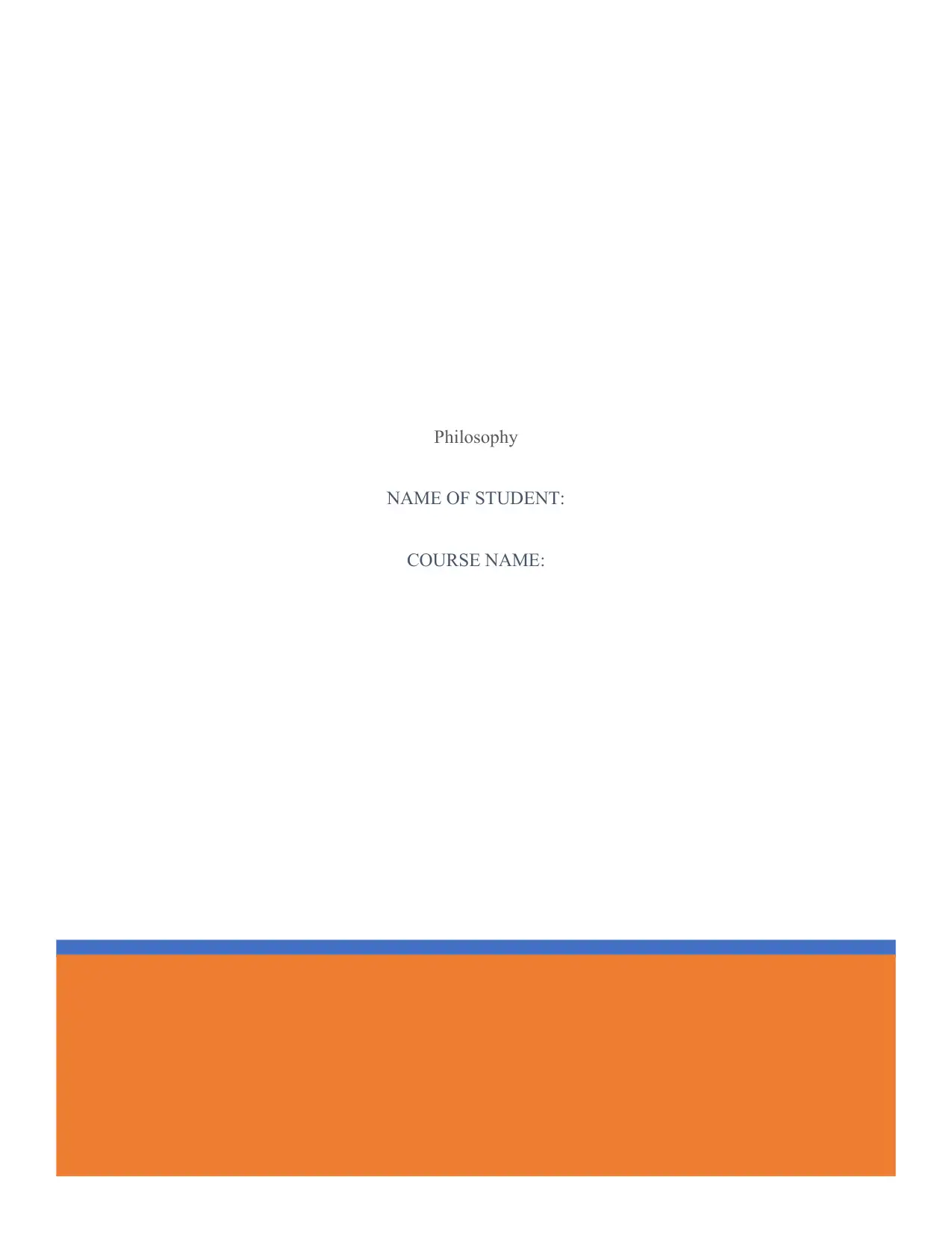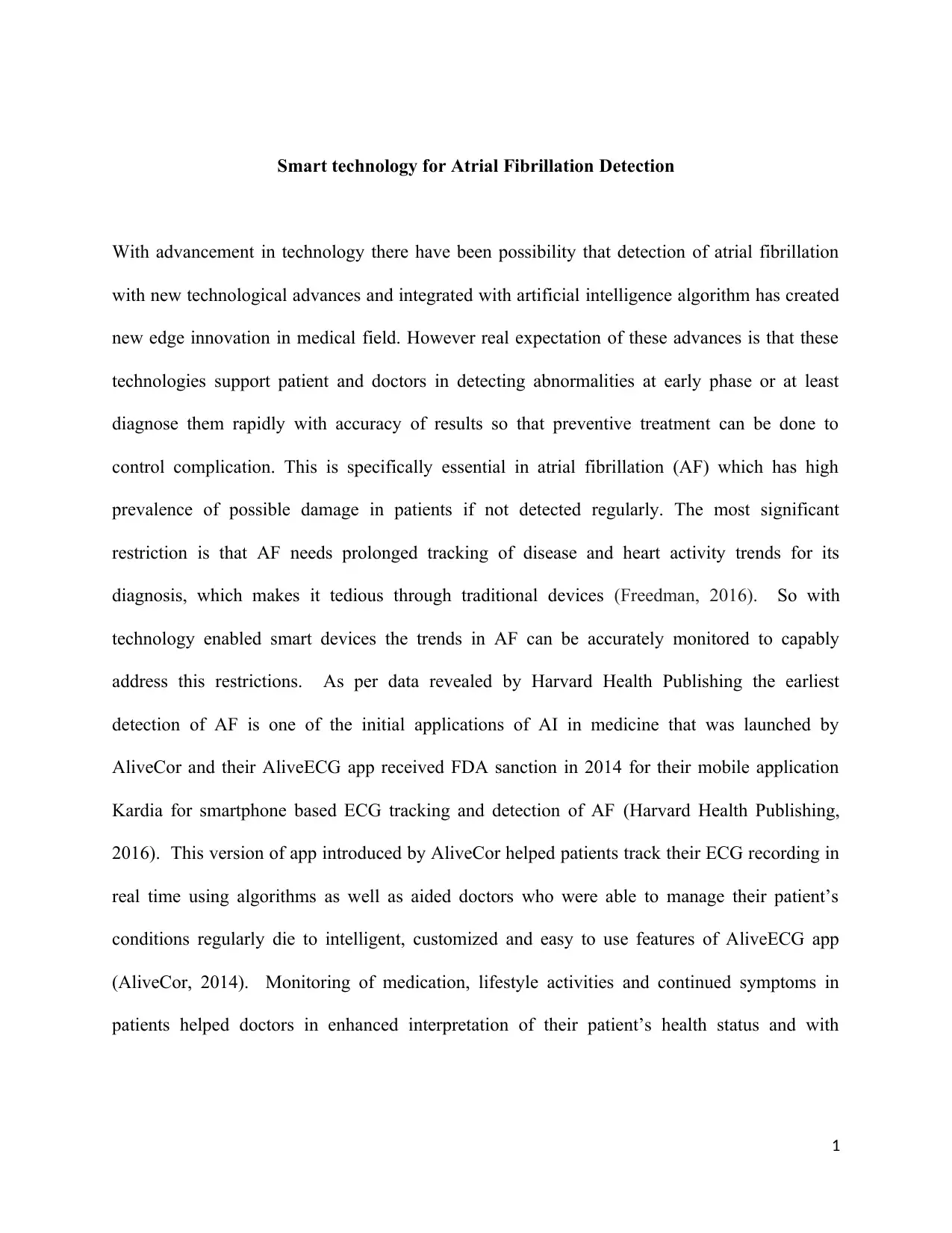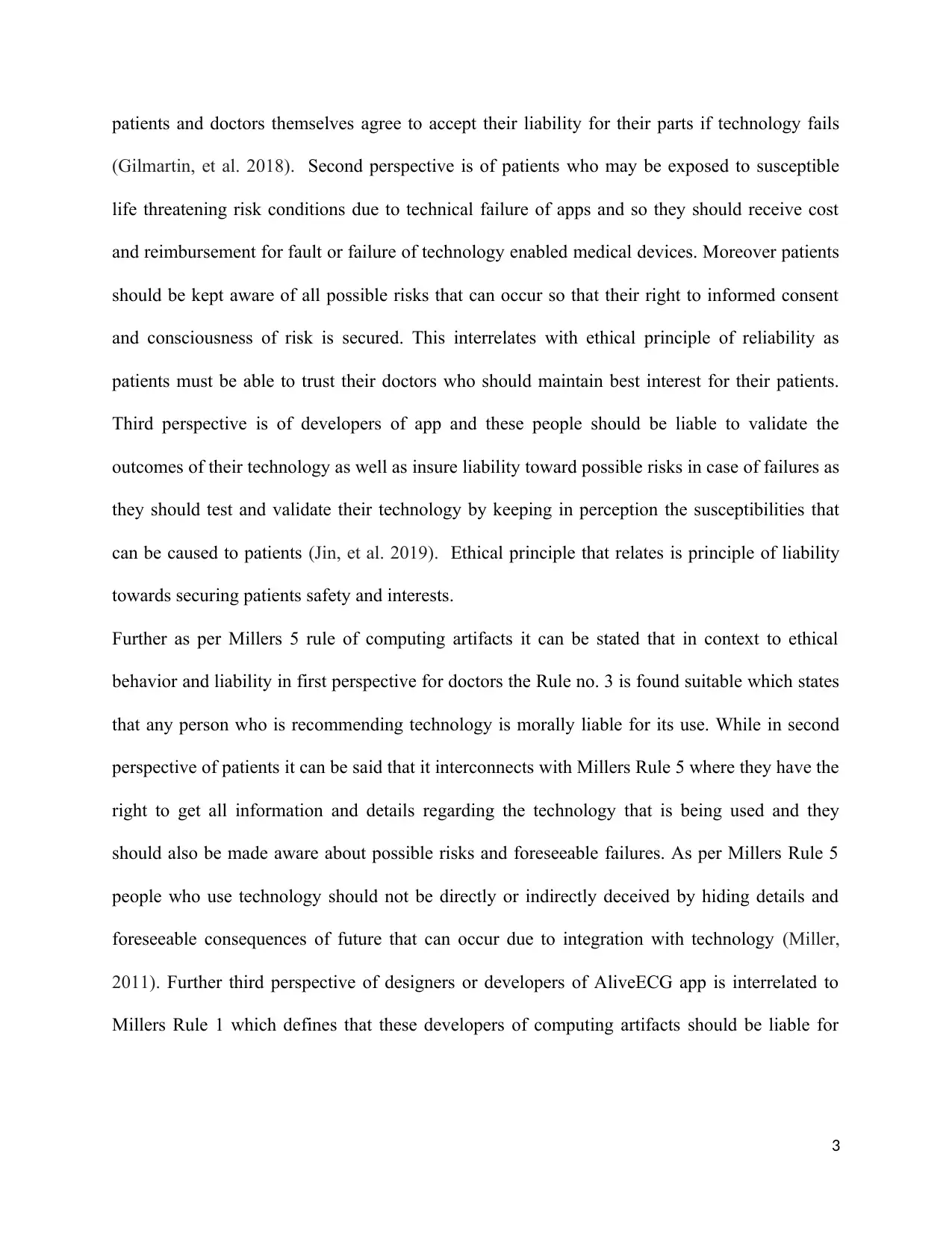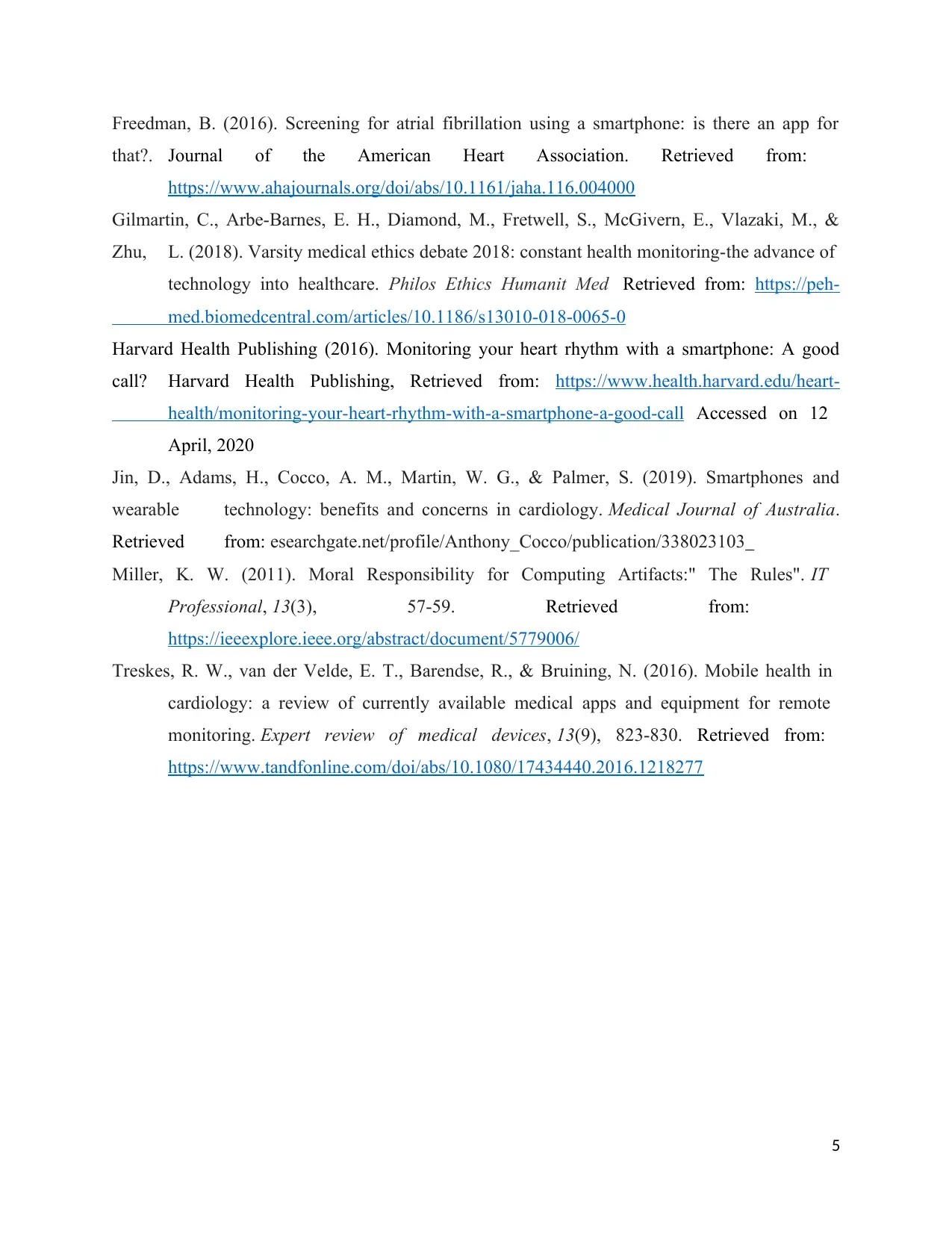AI Ethics: Smart Technology for Atrial Fibrillation Detection Analysis
VerifiedAdded on 2022/09/18
|7
|1549
|19
Case Study
AI Summary
This case study analyzes the ethical considerations of using smart technology, specifically the AliveECG app, for atrial fibrillation (AF) detection. The solution examines the application of AI in medicine, highlighting how these technologies aim to improve early diagnosis and patient care. The analysis identifies key stakeholders (patients, doctors, and developers) and addresses technical and ethical concerns, such as inaccurate results and software bugs. The study applies ethical principles from different perspectives, including doctors, patients, and developers, and integrates Miller's five rules of computing artifacts to assess moral responsibility and liability. The solution suggests that all stakeholders should be liable for potential damages, and that collaboration among doctors, AI experts, and developers is essential to build high-quality, precision-focused innovations and reduce complications. References include AliveCor, Harvard Health Publishing, and relevant articles.

Philosophy
NAME OF STUDENT:
COURSE NAME:
NAME OF STUDENT:
COURSE NAME:
Paraphrase This Document
Need a fresh take? Get an instant paraphrase of this document with our AI Paraphraser

Smart technology for Atrial Fibrillation Detection
With advancement in technology there have been possibility that detection of atrial fibrillation
with new technological advances and integrated with artificial intelligence algorithm has created
new edge innovation in medical field. However real expectation of these advances is that these
technologies support patient and doctors in detecting abnormalities at early phase or at least
diagnose them rapidly with accuracy of results so that preventive treatment can be done to
control complication. This is specifically essential in atrial fibrillation (AF) which has high
prevalence of possible damage in patients if not detected regularly. The most significant
restriction is that AF needs prolonged tracking of disease and heart activity trends for its
diagnosis, which makes it tedious through traditional devices (Freedman, 2016). So with
technology enabled smart devices the trends in AF can be accurately monitored to capably
address this restrictions. As per data revealed by Harvard Health Publishing the earliest
detection of AF is one of the initial applications of AI in medicine that was launched by
AliveCor and their AliveECG app received FDA sanction in 2014 for their mobile application
Kardia for smartphone based ECG tracking and detection of AF (Harvard Health Publishing,
2016). This version of app introduced by AliveCor helped patients track their ECG recording in
real time using algorithms as well as aided doctors who were able to manage their patient’s
conditions regularly die to intelligent, customized and easy to use features of AliveECG app
(AliveCor, 2014). Monitoring of medication, lifestyle activities and continued symptoms in
patients helped doctors in enhanced interpretation of their patient’s health status and with
1
With advancement in technology there have been possibility that detection of atrial fibrillation
with new technological advances and integrated with artificial intelligence algorithm has created
new edge innovation in medical field. However real expectation of these advances is that these
technologies support patient and doctors in detecting abnormalities at early phase or at least
diagnose them rapidly with accuracy of results so that preventive treatment can be done to
control complication. This is specifically essential in atrial fibrillation (AF) which has high
prevalence of possible damage in patients if not detected regularly. The most significant
restriction is that AF needs prolonged tracking of disease and heart activity trends for its
diagnosis, which makes it tedious through traditional devices (Freedman, 2016). So with
technology enabled smart devices the trends in AF can be accurately monitored to capably
address this restrictions. As per data revealed by Harvard Health Publishing the earliest
detection of AF is one of the initial applications of AI in medicine that was launched by
AliveCor and their AliveECG app received FDA sanction in 2014 for their mobile application
Kardia for smartphone based ECG tracking and detection of AF (Harvard Health Publishing,
2016). This version of app introduced by AliveCor helped patients track their ECG recording in
real time using algorithms as well as aided doctors who were able to manage their patient’s
conditions regularly die to intelligent, customized and easy to use features of AliveECG app
(AliveCor, 2014). Monitoring of medication, lifestyle activities and continued symptoms in
patients helped doctors in enhanced interpretation of their patient’s health status and with
1

advanced attributes, graphical trends a more comprehensive and reliable outlook of patients
health status was possible through AliveEGG.
The primary stakeholders of the case of AliveECG are patients and doctors who are involved in
use and recommendation of these apps to track AF conditions which are life threatening
conditions. Patients suffering from heart conditions or known case of AF are those who are
primarily impacted by results and reliability rate of AliveECG app as they have believed and
trusted the claims made. The secondary stakeholders are designers or developer of AliveECG
app who are professional involved in designing, testing and deployment of these computing
artifacts.
The technical concerns in case of AliveECG app can emerge from non-functionality of
algorithms due to which apps provide inaccurate results and records of ECG of patients. Another
technical concern may emerge due to software bug that may interrupt the app and crash the
software (Flaherty, 2014). These technology failures often emerge when designers and
developer of apps do not correctly design or test these computing artifacts before these versions
are launched. Ethically usage of such nonfunctional and faulty technology devices can generate
issues of susceptible exposure of risk for patients who may be not aware of these possible
failures. Even doctors and developers of technology enabled medical apps are surrounded by
ethical issues when these computing artifacts fail which leads to sense of poor liability for failure
and shifting of blames (Treskes, van der Velde, Barendse & Bruining, 2016). These ethical
issues can be related to ethical principles from three diverse outlook, first in perspective of
doctors it is suitable that they develop a legal contract with patients that relieves them from any
liability due to technical failures as these are not caused by doctors lack of capability to do their
job. This will make doctors interconnect with ethical principle of transparency where both
2
health status was possible through AliveEGG.
The primary stakeholders of the case of AliveECG are patients and doctors who are involved in
use and recommendation of these apps to track AF conditions which are life threatening
conditions. Patients suffering from heart conditions or known case of AF are those who are
primarily impacted by results and reliability rate of AliveECG app as they have believed and
trusted the claims made. The secondary stakeholders are designers or developer of AliveECG
app who are professional involved in designing, testing and deployment of these computing
artifacts.
The technical concerns in case of AliveECG app can emerge from non-functionality of
algorithms due to which apps provide inaccurate results and records of ECG of patients. Another
technical concern may emerge due to software bug that may interrupt the app and crash the
software (Flaherty, 2014). These technology failures often emerge when designers and
developer of apps do not correctly design or test these computing artifacts before these versions
are launched. Ethically usage of such nonfunctional and faulty technology devices can generate
issues of susceptible exposure of risk for patients who may be not aware of these possible
failures. Even doctors and developers of technology enabled medical apps are surrounded by
ethical issues when these computing artifacts fail which leads to sense of poor liability for failure
and shifting of blames (Treskes, van der Velde, Barendse & Bruining, 2016). These ethical
issues can be related to ethical principles from three diverse outlook, first in perspective of
doctors it is suitable that they develop a legal contract with patients that relieves them from any
liability due to technical failures as these are not caused by doctors lack of capability to do their
job. This will make doctors interconnect with ethical principle of transparency where both
2
⊘ This is a preview!⊘
Do you want full access?
Subscribe today to unlock all pages.

Trusted by 1+ million students worldwide

patients and doctors themselves agree to accept their liability for their parts if technology fails
(Gilmartin, et al. 2018). Second perspective is of patients who may be exposed to susceptible
life threatening risk conditions due to technical failure of apps and so they should receive cost
and reimbursement for fault or failure of technology enabled medical devices. Moreover patients
should be kept aware of all possible risks that can occur so that their right to informed consent
and consciousness of risk is secured. This interrelates with ethical principle of reliability as
patients must be able to trust their doctors who should maintain best interest for their patients.
Third perspective is of developers of app and these people should be liable to validate the
outcomes of their technology as well as insure liability toward possible risks in case of failures as
they should test and validate their technology by keeping in perception the susceptibilities that
can be caused to patients (Jin, et al. 2019). Ethical principle that relates is principle of liability
towards securing patients safety and interests.
Further as per Millers 5 rule of computing artifacts it can be stated that in context to ethical
behavior and liability in first perspective for doctors the Rule no. 3 is found suitable which states
that any person who is recommending technology is morally liable for its use. While in second
perspective of patients it can be said that it interconnects with Millers Rule 5 where they have the
right to get all information and details regarding the technology that is being used and they
should also be made aware about possible risks and foreseeable failures. As per Millers Rule 5
people who use technology should not be directly or indirectly deceived by hiding details and
foreseeable consequences of future that can occur due to integration with technology (Miller,
2011). Further third perspective of designers or developers of AliveECG app is interrelated to
Millers Rule 1 which defines that these developers of computing artifacts should be liable for
3
(Gilmartin, et al. 2018). Second perspective is of patients who may be exposed to susceptible
life threatening risk conditions due to technical failure of apps and so they should receive cost
and reimbursement for fault or failure of technology enabled medical devices. Moreover patients
should be kept aware of all possible risks that can occur so that their right to informed consent
and consciousness of risk is secured. This interrelates with ethical principle of reliability as
patients must be able to trust their doctors who should maintain best interest for their patients.
Third perspective is of developers of app and these people should be liable to validate the
outcomes of their technology as well as insure liability toward possible risks in case of failures as
they should test and validate their technology by keeping in perception the susceptibilities that
can be caused to patients (Jin, et al. 2019). Ethical principle that relates is principle of liability
towards securing patients safety and interests.
Further as per Millers 5 rule of computing artifacts it can be stated that in context to ethical
behavior and liability in first perspective for doctors the Rule no. 3 is found suitable which states
that any person who is recommending technology is morally liable for its use. While in second
perspective of patients it can be said that it interconnects with Millers Rule 5 where they have the
right to get all information and details regarding the technology that is being used and they
should also be made aware about possible risks and foreseeable failures. As per Millers Rule 5
people who use technology should not be directly or indirectly deceived by hiding details and
foreseeable consequences of future that can occur due to integration with technology (Miller,
2011). Further third perspective of designers or developers of AliveECG app is interrelated to
Millers Rule 1 which defines that these developers of computing artifacts should be liable for
3
Paraphrase This Document
Need a fresh take? Get an instant paraphrase of this document with our AI Paraphraser

their artifacts as well as their outcomes in future. Thus designers or developers of medical apps
should be more liable for their innovation and possible consequences.
This solution insures interest of both stakeholders involved in the case as they remain liable to
insure that their patients health status is kept in priority and so it should withstand criticism as it
integrates ethical principles and insures that all people involved are liable first and foremost to
maintain patients wellbeing. Moreover ethically and judiciously the solution secures patients
interest and even insures that no single stakeholder involved is given entire blame for any
possible outcomes or damages.
Also after analysis of ethical principles I can suggest that all stakeholders involved should be
made liable for any potential damages due to technology enabled medical devices so that
potential of reducing susceptible risks to patient is reduced. Also through such solutions critics of
technology can appease innovations and future concerns and complication can be addressed if
both doctors, artificial intelligence experts work in collaboration with designers and developer of
technology so that high quality and precision focused innovations are built and executed to
reduce complications.
References
AliveCor (2014). AliveCor launches new app to auto detect Atrial Fibrillation in an ECG
recording. AliveCor. Retrieved from:
https://www.alivecor.com/press/press_release/alivecor-launches-new-app-to-auto-detect-
atrial-fibrillation-in-an-ecg-recording/ Accessed on 12 April, 2020
Flaherty, J. L. (2014). Digital diagnosis: privacy and the regulation of mobile phone health
applications. Am. JL & Med., 40, 416. Retrieved from:
https://heinonline.org/HOL/LandingPage?handle=hein.journals/amlmed40&div=26&id=
&page=
4
should be more liable for their innovation and possible consequences.
This solution insures interest of both stakeholders involved in the case as they remain liable to
insure that their patients health status is kept in priority and so it should withstand criticism as it
integrates ethical principles and insures that all people involved are liable first and foremost to
maintain patients wellbeing. Moreover ethically and judiciously the solution secures patients
interest and even insures that no single stakeholder involved is given entire blame for any
possible outcomes or damages.
Also after analysis of ethical principles I can suggest that all stakeholders involved should be
made liable for any potential damages due to technology enabled medical devices so that
potential of reducing susceptible risks to patient is reduced. Also through such solutions critics of
technology can appease innovations and future concerns and complication can be addressed if
both doctors, artificial intelligence experts work in collaboration with designers and developer of
technology so that high quality and precision focused innovations are built and executed to
reduce complications.
References
AliveCor (2014). AliveCor launches new app to auto detect Atrial Fibrillation in an ECG
recording. AliveCor. Retrieved from:
https://www.alivecor.com/press/press_release/alivecor-launches-new-app-to-auto-detect-
atrial-fibrillation-in-an-ecg-recording/ Accessed on 12 April, 2020
Flaherty, J. L. (2014). Digital diagnosis: privacy and the regulation of mobile phone health
applications. Am. JL & Med., 40, 416. Retrieved from:
https://heinonline.org/HOL/LandingPage?handle=hein.journals/amlmed40&div=26&id=
&page=
4

Freedman, B. (2016). Screening for atrial fibrillation using a smartphone: is there an app for
that?. Journal of the American Heart Association. Retrieved from:
https://www.ahajournals.org/doi/abs/10.1161/jaha.116.004000
Gilmartin, C., Arbe-Barnes, E. H., Diamond, M., Fretwell, S., McGivern, E., Vlazaki, M., &
Zhu, L. (2018). Varsity medical ethics debate 2018: constant health monitoring-the advance of
technology into healthcare. Philos Ethics Humanit Med Retrieved from: https://peh-
med.biomedcentral.com/articles/10.1186/s13010-018-0065-0
Harvard Health Publishing (2016). Monitoring your heart rhythm with a smartphone: A good
call? Harvard Health Publishing, Retrieved from: https://www.health.harvard.edu/heart-
health/monitoring-your-heart-rhythm-with-a-smartphone-a-good-call Accessed on 12
April, 2020
Jin, D., Adams, H., Cocco, A. M., Martin, W. G., & Palmer, S. (2019). Smartphones and
wearable technology: benefits and concerns in cardiology. Medical Journal of Australia.
Retrieved from: esearchgate.net/profile/Anthony_Cocco/publication/338023103_
Miller, K. W. (2011). Moral Responsibility for Computing Artifacts:" The Rules". IT
Professional, 13(3), 57-59. Retrieved from:
https://ieeexplore.ieee.org/abstract/document/5779006/
Treskes, R. W., van der Velde, E. T., Barendse, R., & Bruining, N. (2016). Mobile health in
cardiology: a review of currently available medical apps and equipment for remote
monitoring. Expert review of medical devices, 13(9), 823-830. Retrieved from:
https://www.tandfonline.com/doi/abs/10.1080/17434440.2016.1218277
5
that?. Journal of the American Heart Association. Retrieved from:
https://www.ahajournals.org/doi/abs/10.1161/jaha.116.004000
Gilmartin, C., Arbe-Barnes, E. H., Diamond, M., Fretwell, S., McGivern, E., Vlazaki, M., &
Zhu, L. (2018). Varsity medical ethics debate 2018: constant health monitoring-the advance of
technology into healthcare. Philos Ethics Humanit Med Retrieved from: https://peh-
med.biomedcentral.com/articles/10.1186/s13010-018-0065-0
Harvard Health Publishing (2016). Monitoring your heart rhythm with a smartphone: A good
call? Harvard Health Publishing, Retrieved from: https://www.health.harvard.edu/heart-
health/monitoring-your-heart-rhythm-with-a-smartphone-a-good-call Accessed on 12
April, 2020
Jin, D., Adams, H., Cocco, A. M., Martin, W. G., & Palmer, S. (2019). Smartphones and
wearable technology: benefits and concerns in cardiology. Medical Journal of Australia.
Retrieved from: esearchgate.net/profile/Anthony_Cocco/publication/338023103_
Miller, K. W. (2011). Moral Responsibility for Computing Artifacts:" The Rules". IT
Professional, 13(3), 57-59. Retrieved from:
https://ieeexplore.ieee.org/abstract/document/5779006/
Treskes, R. W., van der Velde, E. T., Barendse, R., & Bruining, N. (2016). Mobile health in
cardiology: a review of currently available medical apps and equipment for remote
monitoring. Expert review of medical devices, 13(9), 823-830. Retrieved from:
https://www.tandfonline.com/doi/abs/10.1080/17434440.2016.1218277
5
⊘ This is a preview!⊘
Do you want full access?
Subscribe today to unlock all pages.

Trusted by 1+ million students worldwide

6
1 out of 7
Related Documents
Your All-in-One AI-Powered Toolkit for Academic Success.
+13062052269
info@desklib.com
Available 24*7 on WhatsApp / Email
![[object Object]](/_next/static/media/star-bottom.7253800d.svg)
Unlock your academic potential
Copyright © 2020–2025 A2Z Services. All Rights Reserved. Developed and managed by ZUCOL.




